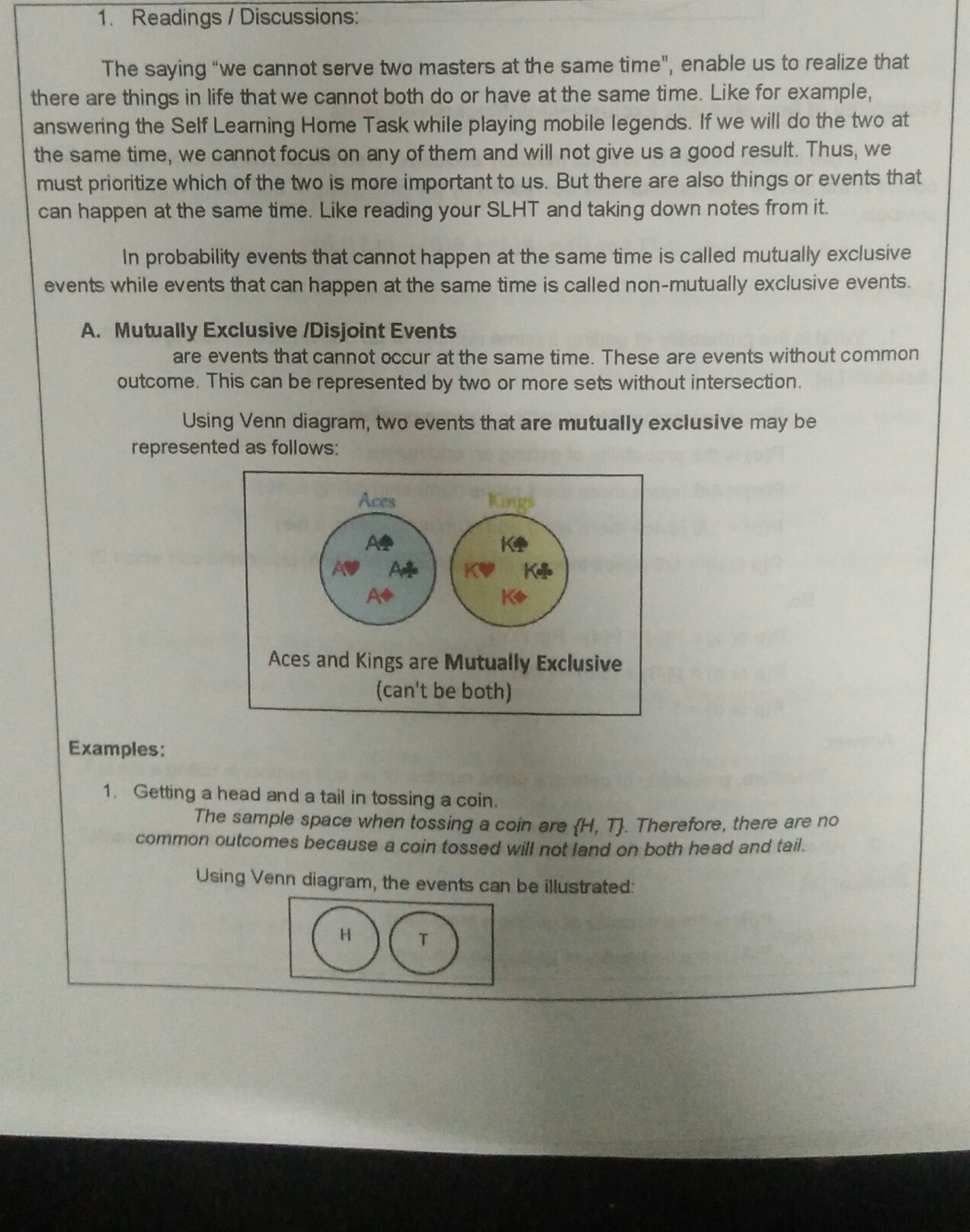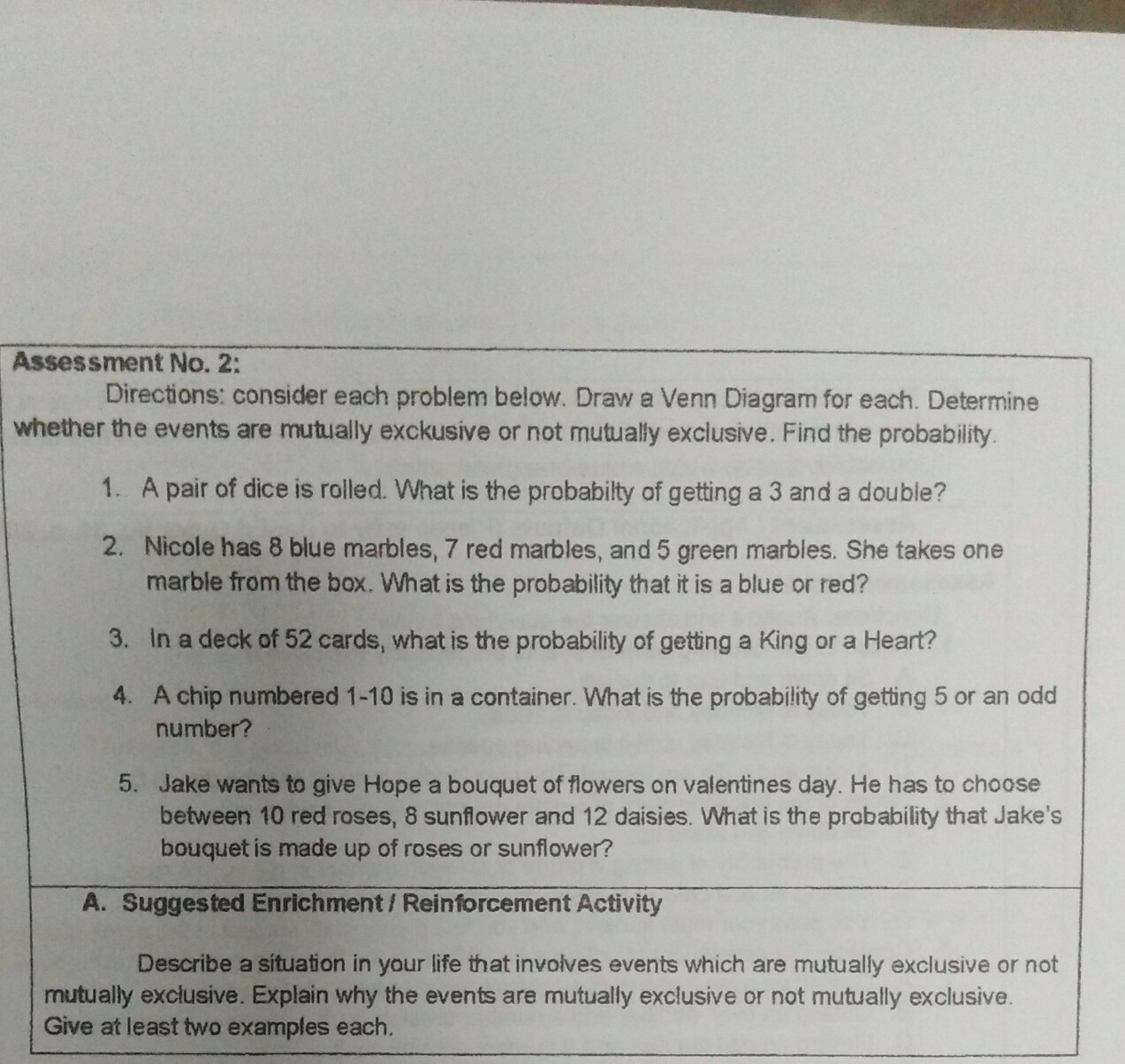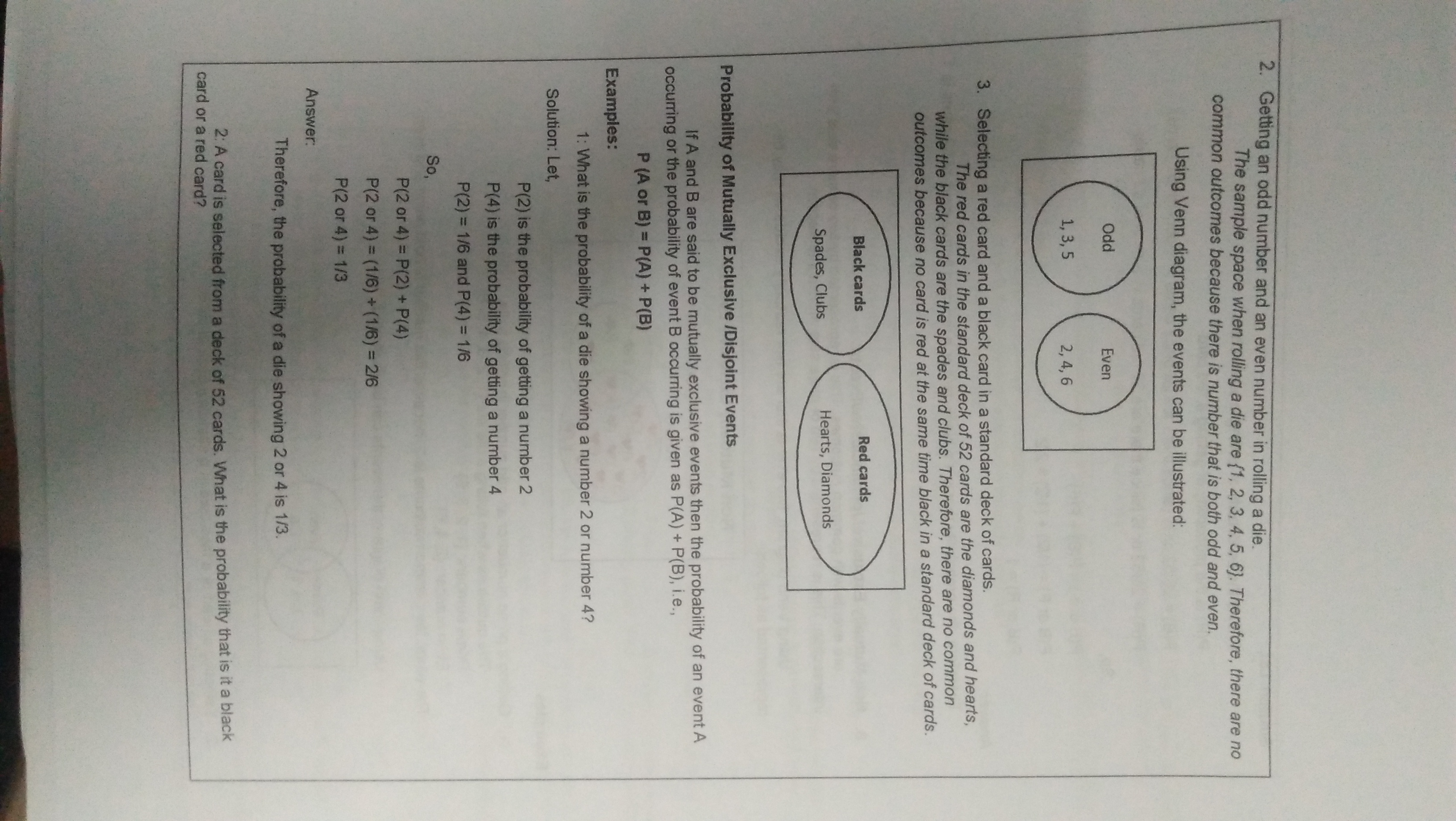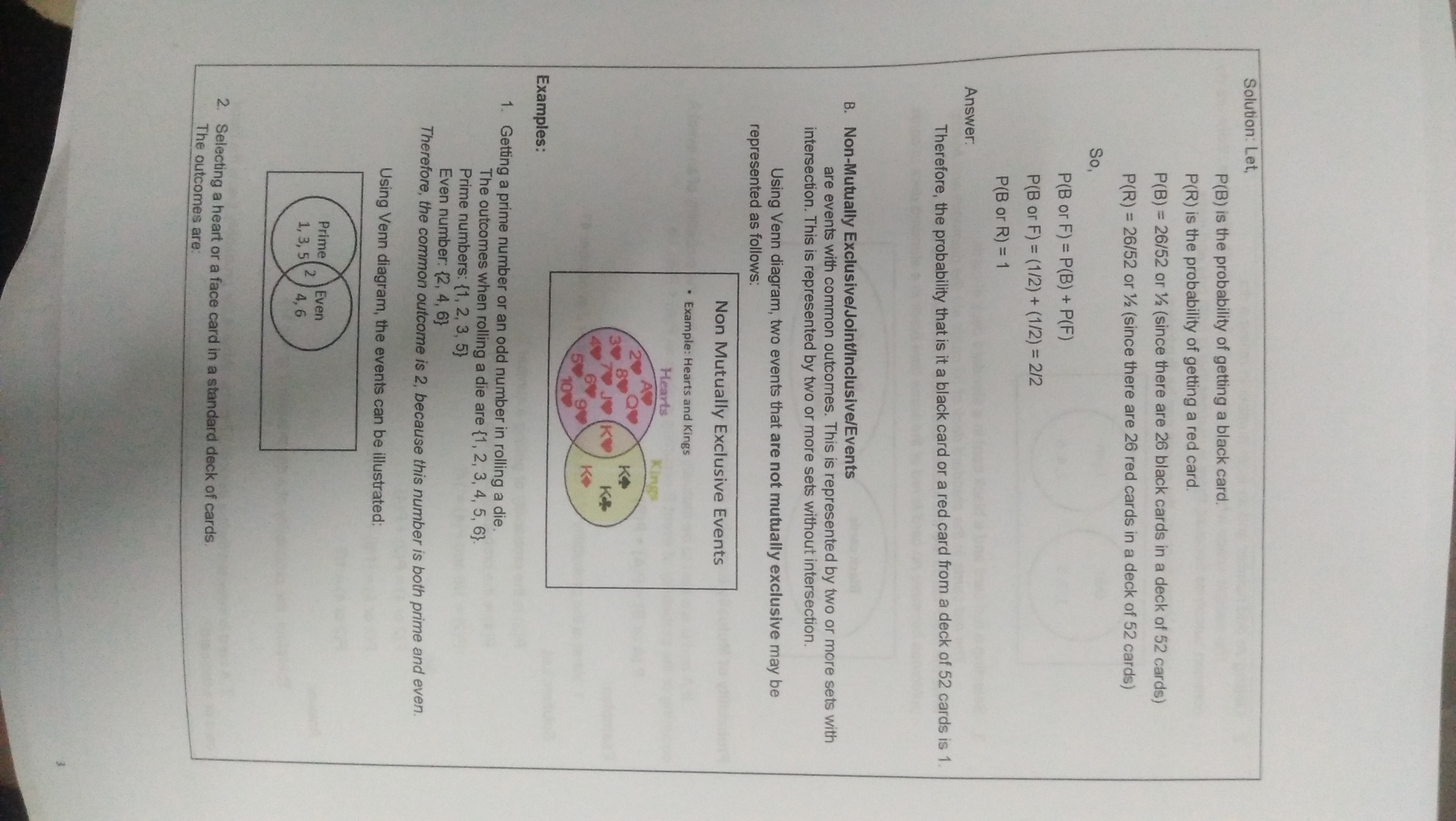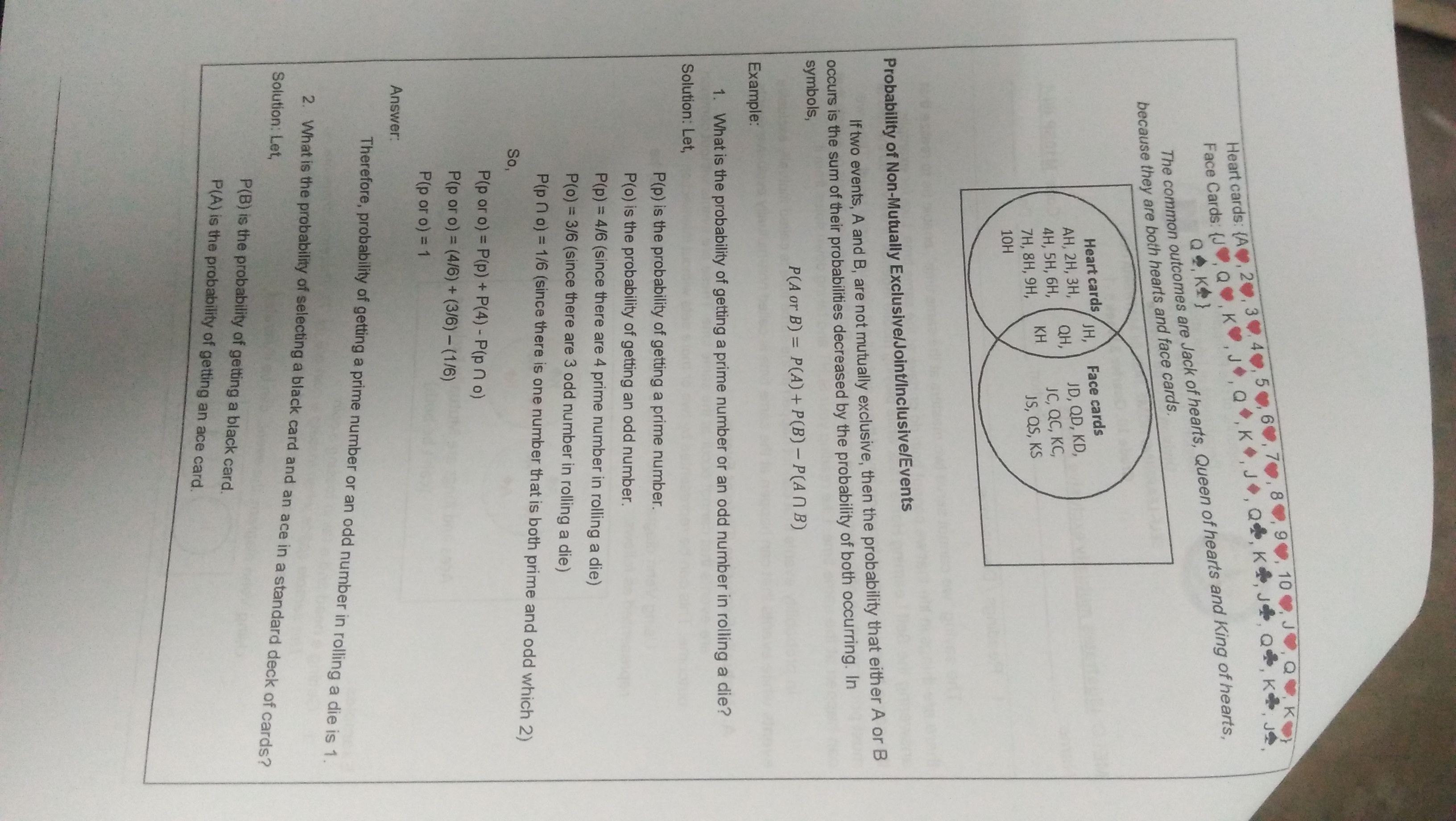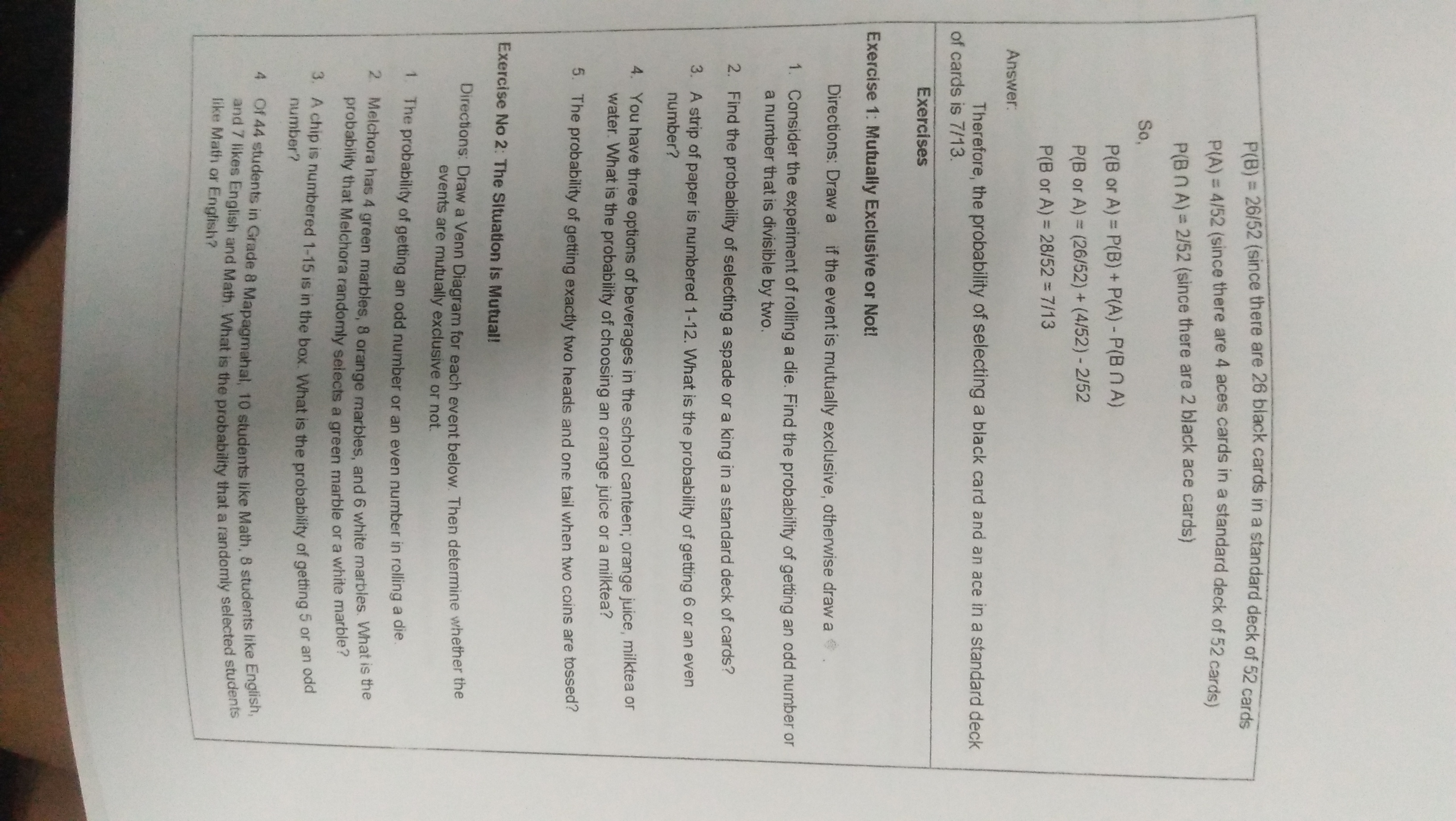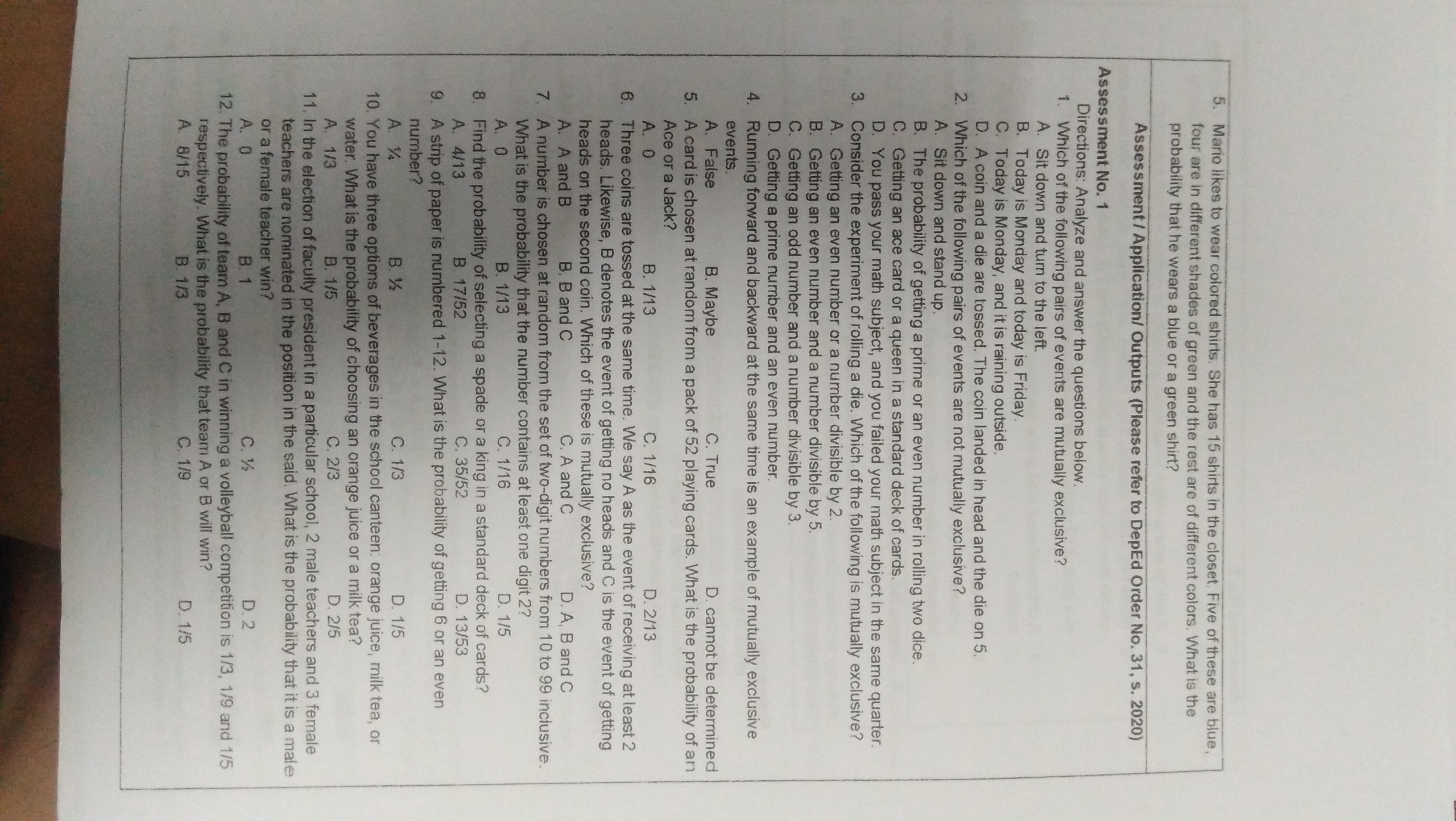BEEN STUCK HERE FOR HOURS
1. Readings / Discussions: The saying "we cannot serve two masters at the same time", enable us to realize that there are things in life that we cannot both do or have at the same time. Like for example, answering the Self Learning Home Task while playing mobile legends. If we will do the two at the same time, we cannot focus on any of them and will not give us a good result. Thus, we must prioritize which of the two is more important to us. But there are also things or events that can happen at the same time. Like reading your SLHT and taking down notes from it. In probability events that cannot happen at the same time is called mutually exclusive events while events that can happen at the same time is called non-mutually exclusive events. A. Mutually Exclusive /Disjoint Events are events that cannot occur at the same time. These are events without common outcome. This can be represented by two or more sets without intersection. Using Venn diagram, two events that are mutually exclusive may be represented as follows: Aces Kings At KY Aces and Kings are Mutually Exclusive (can't be both) Examples: 1. Getting a head and a tail in tossing a coin. The sample space when tossing a coin are {H, T}. Therefore, there are no common outcomes because a coin tossed will not land on both head and tail. Using Venn diagram, the events can be illustrated: HAssessment No. 2: Directions: consider each problem below. Draw a Venn Diagram for each. Determine whether the events are mutually exclusive or not mutually exclusive. Find the probability. 1. A pair of dice is rolled. What is the probabilty of getting a 3 and a double? 2. Nicole has 8 blue marbles, 7 red marbles, and 5 green marbles. She takes one marble from the box. What is the probability that it is a blue or red? 3. In a deck of 52 cards, what is the probability of getting a King or a Heart? 4. A chip numbered 1-10 is in a container. What is the probability of getting 5 or an odd number? 5. Jake wants to give Hope a bouquet of flowers on valentines day. He has to choose between 10 red roses, 8 sunflower and 12 daisies. What is the probability that Jake's bouquet is made up of roses or sunflower? A. Suggested Enrichment / Reinforcement Activity Describe a situation in your life that involves events which are mutually exclusive or not mutually exclusive. Explain why the events are mutually exclusive or not mutually exclusive. Give at least two examples each.2. Getting an odd number and an even number in rolling a die. The sample space when rolling a die are {1, 2, 3, 4, 5, 6}. Therefore, there are no common outcomes because there is number that is both odd and even. Using Venn diagram, the events can be illustrated: Odd Even 1, 3, 5 2 , 4 , 6 3. Selecting a red card and a black card in a standard deck of cards. The red cards in the standard deck of 52 cards are the diamonds and hearts, while the black cards are the spades and clubs. Therefore, there are no common outcomes because no card is red at the same time black in a standard deck of cards. Black cards Red cards Spades, Clubs Hearts, Diamonds Probability of Mutually Exclusive /Disjoint Events If A and B are said to be mutually exclusive events then the probability of an event A occurring or the probability of event B occurring is given as P(A) + P(B), i.e., P (A or B) = P(A) + P(B) Examples: 1: What is the probability of a die showing a number 2 or number 4? Solution: Let, P(2) is the probability of getting a number 2 P(4) is the probability of getting a number 4 P(2) = 1/6 and P(4) = 1/6 So , P(2 or 4) = P(2) + P(4) P(2 or 4) = (1/6) + (1/6) = 2/6 P(2 or 4) = 1/3 Answer: Therefore, the probability of a die showing 2 or 4 is 1/3. 2: A card is selected from a deck of 52 cards. What is the probability that is it a black card or a red card?Solution: Let, P(B) is the probability of getting a black card. P(R) is the probability of getting a red card. P(B) = 26/52 or 1/2 (since there are 26 black cards in a deck of 52 cards) P(R) = 26/52 or 1/2 (since there are 26 red cards in a deck of 52 cards) So , P (B or F) = P(B) + P(F) P (B or F) = (1/2) + (1/2) = 212 P(B or R) = 1 Answer: Therefore, the probability that is it a black card or a red card from a deck of 52 cards is 1. B. Non-Mutually Exclusive/Joint/Inclusive/Events are events with common outcomes. This is represented by two or more sets with intersection. This is represented by two or more sets without intersection. Using Venn diagram, two events that are not mutually exclusive may be represented as follows: Non Mutually Exclusive Events . Example: Hearts and Kings Hearts 20 JO 9V KO 10% Examples: 1. Getting a prime number or an odd number in rolling a die. The outcomes when rolling a die are {1, 2, 3, 4, 5, 6}. Prime numbers: {1, 2, 3, 5} Even number: {2, 4, 6} Therefore, the common outcome is 2, because this number is both prime and even. Using Venn diagram, the events can be illustrated: Prime Even 1, 3, 5 2 4, 6 2. Selecting a heart or a face card in a standard deck of cards. The outcomes areHeart cards: (A, 20, 30 40, 50, 60, 70, 80 90, 10 9, JO, Q , KOT Face Cards: (J, Q, K, J$, Q, K., JO, QB, KA, JP, QB, KB; Je Q Q , KO ] The common outcomes are Jack of hearts, Queen of hearts and King of hearts, because they are both hearts and face cards. Heart cards/ JH, Face cards AH, 2H, 3H, JD, QD, KD, QH, 4H, 5H, 6H, JC, QC, KC, 7H, 8H, 9H, KH JS , Qs, KS 10H Probability of Non-Mutually Exclusive/Joint/Inclusive/Events If two events, A and B, are not mutually exclusive, then the probability that either A or B occurs is the sum of their probabilities decreased by the probability of both occurring. In symbols, P(A or B) = P(A) + P(B) - P(An B) Example: 1. What is the probability of getting a prime number or an odd number in rolling a die? Solution: Let, P(p) is the probability of getting a prime number. P(o) is the probability of getting an odd number. P(p) = 4/6 (since there are 4 prime number in rolling a die) P(o) = 3/6 (since there are 3 odd number in rolling a die) P(p no) = 1/6 (since there is one number that is both prime and odd which 2) So P(p or o) = P(p) + P(4 ) - P(p no ) P(p or o) = (4/6) + (3/6) -(1/6) P(p or 0 ) = 1 Answer: Therefore, probability of getting a prime number or an odd number in rolling a die is 1. Solution: Let, 2. What is the probability of selecting a black card and an ace in a standard deck of cards? P(B) is the probability of getting a black card. P(A) is the probability of getting an ace card.P(B) = 26/52 (since there are 26 black cards in a standard deck of 52 cards P(A) = 4/52 (since there are 4 aces cards in a standard deck of 52 cards) P(B n A) = 2/52 (since there are 2 black ace cards) So , P(B or A) = P(B) + P(A) - P(B n A) P(B or A) = (26/52) + (4/52) - 2/52 P(B or A) = 28/52 = 7/13 Answer: Therefore, the probability of selecting a black card and an ace in a standard deck of cards is 7/13. Exercises Exercise 1: Mutually Exclusive or Not! Directions: Draw a if the event is mutually exclusive, otherwise draw a 1. Consider the experiment of rolling a die. Find the probability of getting an odd number or a number that is divisible by two. 2. Find the probability of selecting a spade or a king in a standard deck of cards? 3. A strip of paper is numbered 1-12. What is the probability of getting 6 or an even number? 4. You have three options of beverages in the school canteen; orange juice, milktea or water. What is the probability of choosing an orange juice or a milktea? 5. The probability of getting exactly two heads and one tail when two coins are tossed? Exercise No 2: The Situation Is Mutual! Directions: Draw a Venn Diagram for each event below. Then determine whether the events are mutually exclusive or not. 1. The probability of getting an odd number or an even number in rolling a die. 2. Melchora has 4 green marbles, 8 orange marbles, and 6 white marbles. What is the probability that Melchora randomly selects a green marble or a white marble? 3. A chip is numbered 1-15 is in the box. What is the probability of getting 5 or an odd number? 4 Of 44 students in Grade 8 Mapagmahal, 10 students like Math, 8 students like English, and 7 likes English and Math. What is the probability that a randomly selected students like Math or English?5. Mario likes to wear colored shirts. She has 15 shirts in the closet. Five of these are blue, four are in different shades of green and the rest are of different colors. What is the probability that he wears a blue or a green shirt? Assessment / Application/ Outputs (Please refer to DepEd Order No. 31, s. 2020) Assessment No. 1 Directions: Analyze and answer the questions below. 1. Which of the following pairs of events are mutually exclusive? A. Sit down and turn to the left. B. Today is Monday and today is Friday. C. Today is Monday, and it is raining outside. D. A coin and a die are tossed. The coin landed in head and the die on 5. 2. Which of the following pairs of events are not mutually exclusive? A. Sit down and stand up. B. The probability of getting a prime or an even number in rolling two dice. C. Getting an ace card or a queen in a standard deck of cards. D. You pass your math subject, and you failed your math subject in the same quarter. 3. Consider the experiment of rolling a die. Which of the following is mutually exclusive? A. Getting an even number or a number divisible by 2. B. Getting an even number and a number divisible by 5. C. Getting an odd number and a number divisible by 3. D. Getting a prime number and an even number. 4. Running forward and backward at the same time is an example of mutually exclusive events. A. False B. Maybe C. True D. cannot be determined 5. A card is chosen at random from a pack of 52 playing cards. What is the probability of an Ace or a Jack? A. 0 B. 1/13 C. 1/16 D. 2/13 6. Three coins are tossed at the same time. We say A as the event of receiving at least 2 heads. Likewise, B denotes the event of getting no heads and C is the event of getting heads on the second coin. Which of these is mutually exclusive? A. A and B B. B and C C. A and C D. A, B and C 7. A number is chosen at random from the set of two-digit numbers from 10 to 99 inclusive. What is the probability that the number contains at least one digit 2? A. 0 B. 1/13 C. 1/16 D. 1/5 8. Find the probability of selecting a spade or a king in a standard deck of cards? A. 4/13 B. 17/52 C. 35/52 D. 13/53 9. A strip of paper is numbered 1-12. What is the probability of getting 6 or an even number? A. 1/4 B. 1/2 C. 1/3 D. 1/5 10. You have three options of beverages in the school canteen: orange juice, milk tea, or water. What is the probability of choosing an orange juice or a milk tea? A. 1/3 B. 1/5 C. 2/3 D. 2/5 11. In the election of faculty president in a particular school, 2 male teachers and 3 female teachers are nominated in the position in the said. What is the probability that it is a male or a female teacher win? A. 0 B. 1 C. 1/2 D. 2 12. The probability of team A, B and C in winning a volleyball competition is 1/3, 1/9 and 1/5 respectively. What is the probability that team A or B will win? A. 8/15 B. 1/3 C. 1/9 D. 1/5
